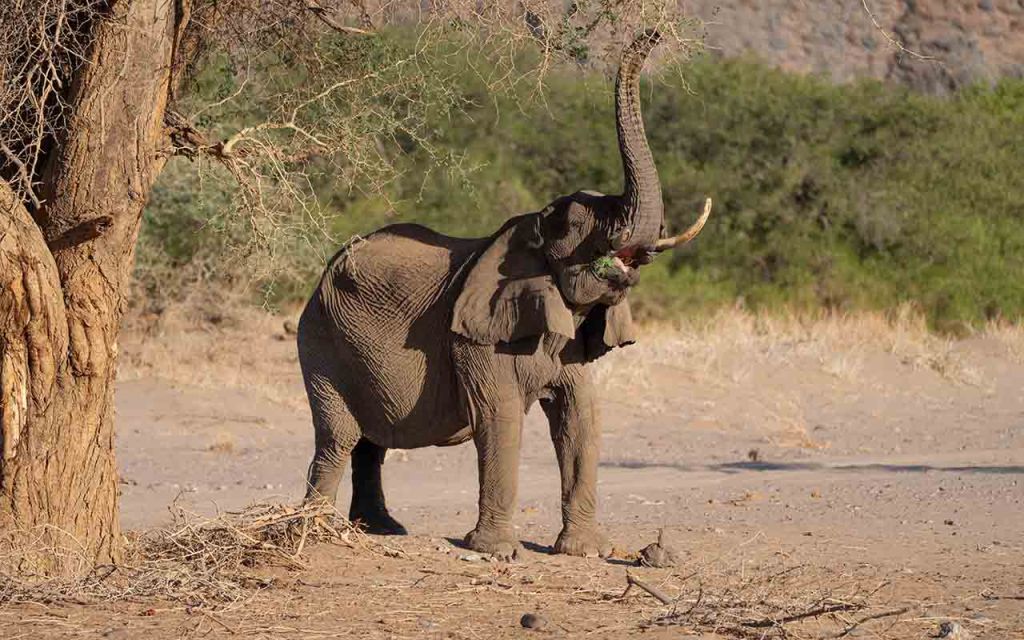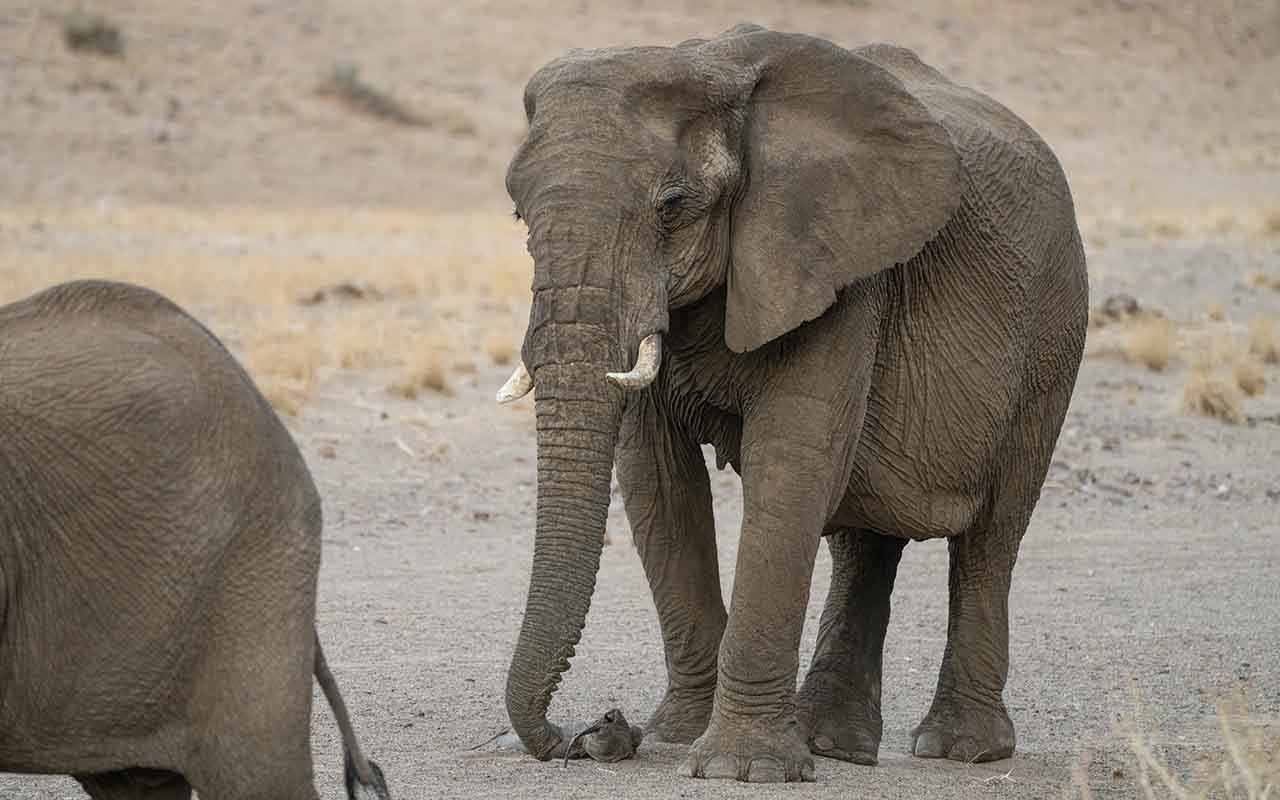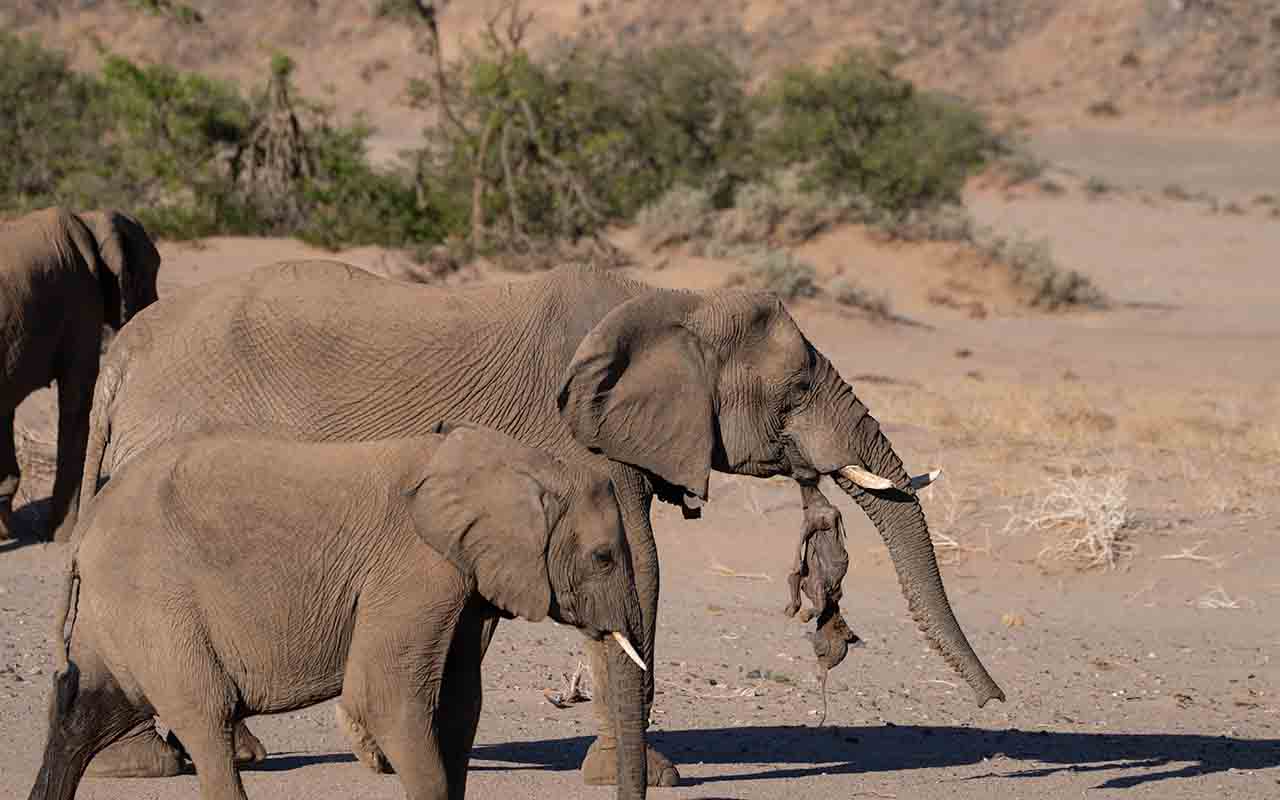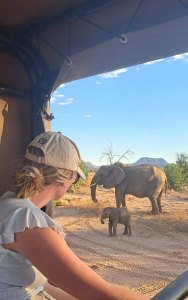Damaraland: barren, rugged and inhospitable. That’s the landscape anyway. The camps on the other hand are the opposite, but that’s not what this week’s focus is on.
In a landscape where you would find it hard to believe that anything existed, black rhinos, giraffes and elephants call this land home. Over years and years and years, they have become adapted to this extreme environment. Living off the scarcest vegetation offerings and with water quantities far reduced compared to what their savannah counterparts are lucky enough to indulge in, surviving as a desert-adapted animal is no easy feat.


During our time in Damaraland we were lucky enough to spend time with said black rhino, giraffe and other game, yet it was with the desert-adapted elephants that a remarkable event unfolded.
We had meandered our way along the dry river bed, tracking the footsteps of these giant pachyderms. We passed under huge weaver nests that provided a brief respite from the heat, checked the freshness of dung and partially broken branches that signalled elephants had passed before us. We could sense we were close, but it wasn’t until the spoor had the glossy sheen that is synonymous with fresh-fresh tracks did we really started to believe we were close.
When we did finally find the elephants in the riverbed, they were milling about as one often sees. Some were dust bathing, others standing still, flapping their ears to keep cool whilst nimbly picking at the green shoots from the trees and shrubs. Desert-adapted elephants are smart, they don’t destroy the vegetation as their savannah cousins do. With the Damaraland rocky crags towering behind them, the scene was pure serenity.

Yet what could have been the happiest of moments, soon turned into one of sadness. One of the female elephants stood away from the herd, focused on a bundle of grey that lay on the floor. Using the end of her trunk to brush over the little mound, she then picked it up and carried it towards the next spot of shade. We soon realised that she was carrying her calf. Having housed the little creature inside her womb for approximately 20 months, the calf was fully formed and was only a couple of months away from being born. Unfortunately, it had been miscarried and now the mother was mourning the loss of what would have been a part of the next generation.

Her temporal glands were secreting, a sign of stress, and she would not let her little one go. Having been lucky enough to witness many an elephant sighting, this was unique to me. Quite incredibly, the female then picked up the calf and actually placed it into her mouth whilst carrying it.



I am not sure why she did this specifically, but it has been observed that mother elephants will carry their dead youngsters for days and sometimes weeks. Often periodically placing them down, sniffing, covering them with dirt and without anthropomorphising too much, coming to terms with their loss. Other members of the herd often also ‘pay their respects’ by coming to the mother’s side and taking part in tactile behaviours like passing their trunks over the dead calf or covering it with dirt.
We will never fully understand the complex nature of an elephant, but being the gentle, caring souls they are, we can assume it is a way in which they mourn their loved ones.
But where there is death, there is also life. Another little calf, healthy and thriving this time, was suckling contently whilst also playing chicken with our vehicle. It was a scene of contrast. One side was filled with grief, yet the other was full of joy.

As the conditions continually get tougher across these wild areas. Be it from the changing climate or human encroachment, it begs the question of which side of the story we will see more of over the coming years. Let us hope it’s the latter!
Thank you as always for reading.

I always love reading your travel adventures. I found it really interesting about the different behavior of the elephants in this type of climate. The loss of the baby was heartbreaking. Thanks for doing what you do and sharing it with all of us.
LikeLike
Thank you so much for your kind words!
It’s a pleasure to be able to bring these tales to you and I’ll make sure the next story is a happy one!
LikeLiked by 1 person
Thank you!
LikeLiked by 1 person
You caught the grief on the mother’s face … so heart-breaking.
LikeLiked by 1 person
This is a fine example of the intelligence of elephants – underrated by many tourists.
LikeLiked by 1 person
I couldn’t agree more!
LikeLike
Wow, an experience filled with sadness but what an incredible thing to witness first hand. I just read this entire post to Michaela and watched the tears well in her eyes as the story unfolded. Yet witnessing natural events is a wonderful experience, even extreme events such as this. We can only hope that our upcoming adventure provides similarly wonderful moments.
LikeLiked by 1 person
I am sure your adventure will be full of wonderful memories.
Unfortunately nature can be cruel, and I’ll make sure the next post is happy one!
LikeLiked by 1 person
Such a sad thing to witness, but I share your fascination with elephant behaviour. We once saw giraffes mourning the death of one of their group (in Chobe) so I know how conflicting it can be – you feel their grief but at the same time are excited to witness something so out of the ordinary.
LikeLiked by 1 person
Oh wow, I bet that was an incredible scene to see though. Giraffes often go unnoticed for their emotions, but as you say Sarah, they also grieve too.
LikeLiked by 1 person
It was incredible – I must write it up for a post one of these days
LikeLiked by 1 person
Yes, please do!
LikeLiked by 1 person
What an incredible memory, a sad one yes……..but still. You captured the moments perfectly and it was surely a heartbreaking moment.
LikeLiked by 1 person
Thank you so much. It certainly wasn’t the easiest thing to write about.
LikeLike